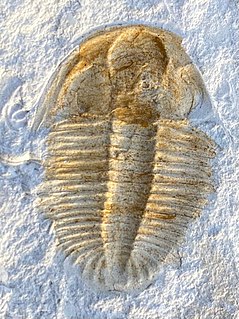Related Research Articles
The Kaili Formation is a stratigraphic formation which was deposited during the Lower and Middle Cambrian. The formation is approximately 200 metres (660 ft) thick and was named after the city Kaili in the Guizhou province of southwest China.
Albansia is an extinct genus from a well-known class of fossil marine arthropods, the trilobites. It lived during the Cambrian Period, which lasted from approximately 539 to 485 million years ago.
Balderia is an extinct genus from a well-known class of fossil marine arthropods, the trilobites. It lived during the Cambrian Period, which lasted from approximately 539 to 485 million years ago.
Chondroparia is an extinct genus from a well-known class of fossil marine arthropods, the trilobites. It lived during the Cambrian Period, which lasted from approximately 539 to 485 million years ago.
Conopolus is an extinct genus from a well-known class of fossil marine arthropods, the trilobites. It lived during the Cambrian Period, which lasted from approximately 539 to 485 million years ago.
Dipentaspis is an extinct genus of damesellid odontopleurid trilobite. It lived during the Cambrian Period, which lasted from approximately 539 to 485 million years ago.
Durinia is an extinct genus from a well-known class of fossil marine arthropods, the trilobites. It lived during the Cambrian Period, which lasted from approximately 539 to 485 million years ago.
Girandia is an extinct genus from a well-known class of fossil marine arthropods, the trilobites. It lived during the Cambrian Period, which lasted from approximately 539 to 485 million years ago.
Hatangia is an extinct genus from a well-known class of fossil marine arthropods, the trilobites. It lived during the Cambrian Period, which lasted from approximately 539 to 485 million years ago in Siberia.
Hastagnostus is an extinct genus from a well-known class of fossil marine arthropods, the trilobites. It lived during the Cambrian Period, which lasted from approximately 539 to 485 million years ago.
Irinia is an extinct genus of trilobites in the family Anomocaridae. It lived during the Cambrian Period that lasted from approximately 539 to 485 million years ago.
Lydiaspis is an extinct genus from a well-known class of fossil marine arthropods, the trilobites. It lived during the Cambrian Period, which lasted from approximately 539 to 485 million years ago.
Wandelella is an extinct genus from a well-known class of fossil marine arthropods, the trilobites. It lived during the Cambrian Period, which lasted from approximately 539 to 485 million years ago.
Tosotychia is an extinct genus from a well-known class of fossil marine arthropods, the trilobites. It lived during the Cambrian Period, which lasted from approximately 539 to 485 million years ago.
Rawlinsella is an extinct genus from a well-known class of fossil marine arthropods, the trilobites. It lived during the Cambrian Period, which lasted from approximately 539 to 485 million years ago.
Oculeus is an extinct genus from a well-known class of fossil marine arthropods, the trilobites. It lived during the Cambrian Period, which lasted from approximately 539 to 485 million years ago.
Schoriella is an extinct genus of trilobites in the family Anomocaridae. The genus lived during the Cambrian Period, which lasted from approximately 539 to 485 million years ago.

Sinodiscus is an extinct genus from a well-known class of fossil marine arthropods, the trilobites. It lived during the late Atdabanian stage, which lasted from 530 to 524 million years ago during the early part of the Cambrian Period.

Xystridura Whitehouse, 1936 is a genus of Redlichiid trilobite described originally from the Middle Cambrian (Miaolingian) strata of Queensland, Australia. The genus ranges upwards from Ordian into Florian Stages in terms of Australian Cambrian stratigraphic nomenclature.
William Harold Fritz was a geologist who worked for the Geological Survey of Canada. He is known for his work in stratigraphy and on olenelloid trilobites.
References
- 1 2 Sepkoski, Jack (2002). "A compendium of fossil marine animal genera (Trilobita entry)". Bulletins of American Paleontology. 364: 560. Archived from the original on 2006-09-05. Retrieved 2008-01-12.
- ↑ Yuan, Jin Liang; Li, Yue; Mu, Xi Nan; et al. (2012). "Trilobite fauna of the Zhangxia Group (Cambrian Stage 3) in Shandong and adjacent regions". Chinese Paleontology. 197 (35).
- ↑ "Stratigraphic Chart 2022" (PDF). International Stratigraphic Commission. February 2022. Retrieved 25 April 2022.